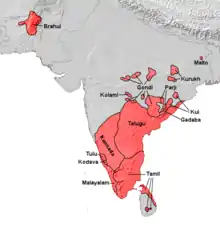Brahui language
Brahui[3] (/brəˈhuːi/;[4] Brahui: براهوئی) is a Dravidian language spoken primarily by the Brahui people in the central part of Balochistan Province, in Pakistan and in scattered parts of Iran, Afghanistan and Turkmenistan[5] and by expatriate Brahui communities in Iraq, Qatar and United Arab Emirates.[6] It is isolated from the nearest Dravidian-speaking neighbour population of South India by a distance of more than 1,500 kilometres (930 mi).[2] The Kalat, Khuzdar, Mastung, Quetta, Bolan, Nasirabad, Noshki, and Kharan districts of Balochistan Province are predominantly Brahui-speaking. Brahui is also spoken in Sindh, mostly in Larkana and Nawabshah divisions.
| Brahui | |
|---|---|
| براهوئی | |
 The word Brahui written in the Nastaliq script | |
| Pronunciation | [bɾaːhuiː] |
| Region | Pakistan, Iran, Afghanistan, Turkmenistan |
| Ethnicity | Brahui |
Native speakers | 3.28 million (2016)[1] |
| Arabic script (Nastaʿlīq ), Latin script | |
| Language codes | |
| ISO 639-3 | brh |
| Glottolog | brah1256 |
 Brahui (far upper left) is geographically isolated from all other Dravidian languages.[2] | |
Distribution
Brahui is spoken in the central part of Pakistani Balochistan, mainly in Kalat, Khuzdar and Mastung districts, but also in smaller numbers in neighboring districts, as well as in Afghanistan which borders Pakistani Balochistan; however, many members of the ethnic group no longer speak Brahui.[2] The 2013 edition of Ethnologue reports that there are 4 million speakers of the language and primarily in the Pakistan province of Balochistan. There are also an unknown very small number of expatriate Brahuis in the Arab States of the Persian Gulf, Iranian Balochistan and Turkmenistan.[6]
History
There is no consensus as to whether Brahui is a relatively recent language introduced into Balochistan or remnant of an older widespread Dravidian language family. According to Josef Elfenbein (1989), the most common theory is that the Brahui were part of a Dravidian invasion of north-western India in the 3rd millennium BC, but unlike other Dravidians who migrated to the south, they remained in Sarawan and Jahlawan since before 2000 BC.[7] However, some other scholars see it as a recent migrant language to its present region. They postulate that Brahui could only have migrated to Balochistan from central India after 1000 AD. This is contradicted by genetic evidence that shows the Brahui population to be indistinguishable from neighbouring Balochi speakers, and genetically distant from central Dravidian speakers.[8][9] The main Iranian contributor to Brahui vocabulary, Balochi, is a Northwestern Iranian language, and moved to the area from the west only around 1000 AD.,[10][11] One scholar places the migration as late as the 13th or 14th century.[12]
Southworth (2012) proposes that Brahui is not a Dravidian language, but can be linked with the remaining Dravidian languages and Elamite to form the “Zagrosian family” which originated in Southwest Asia (southern Iran) and was widely distributed in South Asia and parts of eastern West Asia before the Indo-Aryan migration.[13]
Dialects
There are no important dialectal differences. Jhalawani (southern, centered on Khuzdar) and Sarawani (northern, centered on Kalat) dialects are distinguished by the pronunciation of *h, which is retained only in the north (Elfenbein 1997). Brahui has been influenced by the Iranian languages spoken in the area, including Persian, Balochi and Pashto.[14]
Phonology
Brahui vowels show a partial length distinction between long /aː eː iː oː uː/ and diphthongs /aɪ aʊ/ and short /a u i/.
Brahui consonants show patterns of retroflexion but lack the aspiration distinctions found in surrounding languages and include several fricatives such as the voiceless lateral fricative [ɬ], a sound not otherwise found in the region.[15] Consonants are also very similar to those of Balochi, but Brahui has more fricatives and nasals (Elfenbein 1993).
| Labial | Dental | Alveolar | Retroflex | Palatal | Velar | Glottal | ||||||||
|---|---|---|---|---|---|---|---|---|---|---|---|---|---|---|
| Nasal | m | n | ɳ | (ŋ) | ||||||||||
| Stop | p | b | t | d | ʈ | ɖ | t͡ʃ | d͡ʒ | k | ɡ | ʔ | |||
| Fricative | f | s | z | ʃ | ʒ | x | ɣ | h | ||||||
| Lateral | ɬ | l | ||||||||||||
| Rhotic | ɾ | ɽ | ||||||||||||
| Glide | j | w | ||||||||||||
Stress
Stress in Brahui follows a quantity-based pattern, occurring either on the first long vowel or diphthong, or on the first syllable if all vowels are short.
Orthography
Arabic script
Brahui is the only Dravidian language which is not known to have been written in a Brahmi-based script; instead, it has been written in the Arabic script since the second half of the 20th century.[16] In Iran, Afghanistan and Pakistan, the Nastaʿlīq script is used in writing.
Latin script
More recently, a Roman-based orthography named Brolikva (an abbreviation of Brahui Roman Likvar) was developed by the Brahui Language Board of the University of Balochistan in Quetta and adopted by the newspaper Talár.
Below is the new promoted Bráhuí Báşágal Brolikva orthography:[3]
| b | á | p | í | s | y | ş | v | x | e | z | ź | ģ | f | ú | m | n | l | g | c | t | ŧ | r | ŕ | d | o | đ | h | j | k | a | i | u | ń | ļ |
The letters with diacritics are the long vowels, post-alveolar and retroflex consonants, the voiced velar fricative and the voiceless lateral fricative.
Endangerment
According to a 2009 UNESCO report, Brahui is one of the 27 languages of Pakistan that are facing the danger of extinction. They classify it in "unsafe" status, the least endangered level out of the five levels of concern (Unsafe, Definitely Endangered, Severely Endangered, Critically Endangered and Extinct).[17]
References
- "Brahui". Ethnologue.
- Parkin 1989, p. 37.
- Bráhuí Báşágal, Quetta: Brahui Language Board, University of Balochistan, April 2009, retrieved 2010-06-29
- "Brahui". Oxford English Dictionary (Online ed.). Oxford University Press. (Subscription or participating institution membership required.)
- "A slice of south India in Balochistan". 2017-02-18.
- "International Journal of Dravidian Linguistics, Volumes 36-37" department of linguistics, University of Kerala
- electricpulp.com. "BRAHUI – Encyclopaedia Iranica". www.iranicaonline.org.
- Pagani, Luca; Colonna, Vincenza; Tyler-Smith, Chris; Ayub, Qasim (2017). "An Ethnolinguistic and Genetic Perspective on the Origins of the Dravidian-Speaking Brahui in Pakistan". Man in India. 97 (1): 267–278. PMC 5378296. PMID 28381901.
- Khan, Razib (23 July 2020). "The Brahui, total genetic replacement?". Brown Pundits.
- Witzel 1998, p. 1.
- Elfenbein 1987.
- Sergent 1997, pp. 129–130.
- Southworth, Franklin (2011). "Rice in Dravidian and its linguistic implications". Rice. 4: 142–148. doi:10.1007/s12284-011-9076-9.
- Emeneau 1962, p. .
- Bashir 2016, p. 274.
- "Бесписьменный язык Б." Archived from the original on 2015-06-23. Retrieved 2015-06-23.
- Moseley 2009, p. .
- Haftaí Talár, Talár Publications, archived from the original on 2013-06-24, retrieved 2010-06-29
Sources
- Bashir, Elena (December 2003), "Brahui - Notes" (PDF), South Asian Language Resource Center Workshop on Languages of Afghanistan and neighboring areas, retrieved 2010-06-29
- Bashir, Elena (2016). "Contact and convergence". In Hock, Hans Henrich; Bashir, Elena (eds.). The Languages and Linguistics of South Asia. pp. 241–374. doi:10.1515/9783110423303-004. ISBN 978-3-11-042330-3.
- Bray, Denys. The Brahui Language, an Old Dravidian Language Spoken in Parts of Baluchistan and Sind: Grammar. Gian Publishing House, 1986.
- Elfenbein, J. (1987). "A Periplus of the 'Brahi Problem'". Studia Iranica. 16 (2): 215–233. doi:10.2143/SI.16.2.2014604.
- Emeneau, M. B. (1962). "Bilingualism and Structural Borrowing". Proceedings of the American Philosophical Society. 106 (5): 430–442. JSTOR 985488.
- Moseley, Christopher, ed. (2009), Interactive Atlas of the World's Languages in Danger, UNESCO, OCLC 435877932
- Parkin, Robert (1 January 1989). "Some comments on Brahui kinship terminology". Indo-Iranian Journal. 32 (1): 37–43. doi:10.1007/BF00182435. JSTOR 24654607. S2CID 161638780.
- Sergent, Bernard (1997), Genèse de l'Inde, Bibliothèque scientifique Payot, ISBN 9782228891165, OCLC 38198091
- Witzel, Michael (2008). "The Languages of Harappa: Early Linguistic Data and the Indus civilization". doi:10.11588/xarep.00000120. S2CID 165751802. Cite journal requires
|journal=(help)
External links
| Brahui language test of Wikipedia at Wikimedia Incubator |
- Online Brahui Dictionary
- Handbook of the Birouhi language By Allâh Baksh (1877)
- Brahui Language Board
- Bráhuí Báşágal (Brahui Alphabet)
- Profile of the Brahui language
- Partial bibliography of scholarly works on Brahui
- Britannica Brahui language
- Brahui basic lexicon at the Global Lexicostatistical Database